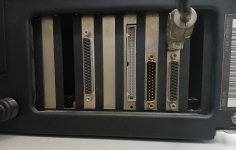mechaniputer
Experienced Member
- Joined
- May 23, 2015
- Messages
- 72
Hi all,
I have a working IBM 5160, with a working hard drive (I believe it to be the original MFM) which I picked up a few years ago. I'm finally tinkering with it and discovered that it didn't come with a drive parking utility of any kind. It came with some software floppies but none of them contain such utilities. I have no experience transferring files to this type of PC and I do not have a working 5.25" floppy drive on any of my more modern machines.
It has DOS 3.3 installed, as well as EZ-Menu, PopDOS, MultiMate, and Lotus 1-2-3. I didn't see anything which would be obviously useful for file transfer but I could have missed something. I am also attaching a photo of the ports on the back of the PC, which also shows what looks like a model/serial number? 5160-4060029

I have a working IBM 5160, with a working hard drive (I believe it to be the original MFM) which I picked up a few years ago. I'm finally tinkering with it and discovered that it didn't come with a drive parking utility of any kind. It came with some software floppies but none of them contain such utilities. I have no experience transferring files to this type of PC and I do not have a working 5.25" floppy drive on any of my more modern machines.
It has DOS 3.3 installed, as well as EZ-Menu, PopDOS, MultiMate, and Lotus 1-2-3. I didn't see anything which would be obviously useful for file transfer but I could have missed something. I am also attaching a photo of the ports on the back of the PC, which also shows what looks like a model/serial number? 5160-4060029
- Is there a way I could write a basic peek/poke or asm routine to park the drive?
- Is there a way I could bootstrap some way to transfer software to it over one of the ports on the back?
- Is there a modern-ish device I could use to run it off a CF/SD card and not deal with the original drive at all?
- Worse case, I can attempt to revive the 5.25 drive on my 386 system and use it as an intermediary to get data to the 5160. Are there any special considerations around disk format if I try this?
- Where can I obtain the correct disk parking utility for this model?

